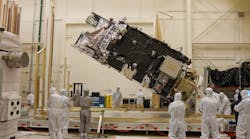A new weather satellite designed to monitor hurricanes and other severe weather more accurately than earlier technology is being prepped for launch at a testing facility in Florida.
The satellite is the first hatchling in the Geostationary Operational Environmental Satellite R Series, or GOES-R, program. The satellite will carry equipment for tracking severe weather and helping to improve warning times for things like tornados and storms. It will also use specialized instruments to measure solar activity on the sun and the concentration of particles and magnetism in the space around earth.
The satellites were designed by Lockheed Martin, which on Monday shipped the first model to its Astrotech Space Operations facility in Titusville, Fla. There, the company will run through the final tests before launch, which is scheduled for early November at the Cape Canaveral Air Force Station.
A United Launch Alliance Atlas V rocket will take the satellite into geosynchronous orbit. Once it starts running, the National Oceanic and Atmospheric Administration will collect data from the sensors and put them into weather models. The aim is to sooner predict storms and other severe weather before it happens.
The satellite’s Advanced Baseline Imager handles the lion’s share of data collection. It is a radiometer - a device for measuring the power of electromagnetic radiation - which probes Earth’s atmosphere using 16 different frequency channels. That represents more than three times the number of spectrum bands used by the current generation of GOES satellites.
The GOES-R satellites will also have four times the spatial resolution and more than five times faster temporal coverage than the current system, according to NASA, which oversees the project with NOAA officials. These capabilities will be useful for monitoring things like cloud formation, ocean currents, volcanic eruptions, air quality, and plant health on Earth’s surface.
The new satellites are part of recent efforts to improve weather forecasting satellites. The NOAA is also updating its Joint Polar Satellite System, a satellite array that gathers atmospheric data with microwave scanners. Last year, NASA began testing a series of eight microsatellites that redirect GPS signals to track the evolution of hurricanes.
